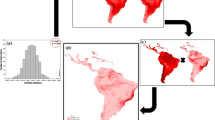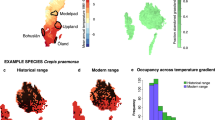Abstract
Potential interactions between climate change and exotic plant invasions may affect areas of high conservation value, such as land set aside for the protection of endangered species or ecological communities. We investigated this issue in eastern Australia using species distribution models for five exotic vines under climate regimes for 2020 and 2050. We examined how projected changes in the distribution of climatically suitable habitat may coincide with the remaining remnants of an endangered ecological community—littoral rainforests—in this region. The number of known infestations of each weed in tropical, subtropical and temperate areas was used to assess the likelihood of further expansion into areas projected to provide suitable habitat under future conditions. Littoral rainforest reserves were consistently predicted to provide bioclimatically suitable habitat for the five vines examined under both current and future climate scenarios. We explore the consequences and potential strategies for managing exotic plant invasions in these protected areas in the coming decades.



Similar content being viewed by others
References
Araujo MB, Pearson RG, Thuiller W, Erhard M (2005) Validation of species-climate impact models under climate change. Glob Change Biol 11:1504–1513. doi:10.1111/j.1365-2486.2005.01000.x
Batianoff GN, Butler DW (2002) Assessment of invasive naturalized plants in south-east Queensland. Plant Prot Quar 17:27–34
Beaumont LJ, McAllan IAW, Hughes L (2006) A matter of timing: Changes in the first date of arrival and last date of departure of Australian migratory birds. Glob Change Biol 12:1339–1354. doi:10.1111/j.1365-2486.2006.01171.x
Beaumont LJ, Gallagher RV, Downey PO, Thuiller W, Leishman MR, Hughes L (2009a) Modeling the impact of Hieracium spp. on protected areas in Australia under future climates. Ecography 32:757–764. doi:10.1111/j.1600-0587.2009.05705.x
Beaumont LJ, Gallagher RV, Thuiller W, Downey PO, Leishman MR, Hughes L (2009b) Different climatic envelopes among invasive populations may lead to underestimations of current and future biological invasions. Divers Distrib 15:409–420. doi:10.1111/j.1472-4642.2008.00547.x
Blood K (2001) Environmental weeds: a field guide for southeast Australia. CH Jerram & Associates, Australia
Bradley BA, Oppenheimer M, Wilcove DS (2009) Climate change and plant invasions: restoration opportunities ahead? Glob Change Biol 15:1511–1521. doi:10.1111/j.1365-2486.2008.01824.x
Buckley YM, Anderson S, Catterall CP, Corlett RT, Engel T, Gosper CR, Nathan R, Richardson DM, Setter M, Spiegel O, Vivian-Smith G, Voigt FA, Weir JES, Westcott DA (2006) Management of plant invasions mediated by frugivore interactions. J Appl Ecol 43:848–857. doi:10.1111/j.1365-2664.2006.01210.x
Carroll SP, Dingle H (1996) The biology of post-invasion events. Biol Conserv 78:207–214. doi:10.1016/0006-3207(96)00029-8
Dirnböck T, Dullinger S (2004) Habitat distribution models, spatial autocorrelation, functional traits and dispersal capacity of alpine plant species. J Veg Sci 15:77–84
Drake JM, Lodge DM (2006) Allee effects, propagule pressure and the probability of establishment: risk analysis for biological invasions. Biol Invasions 8:365–375. doi:10.1007/s10530-004-8122-6
Elith J, Graham CH, Anderson RP, Dudik M, Ferrier S, Guisan A, Hijmans RJ, Huettmann F, Leathwick JR, Lehmann A (2006) Novel methods improve prediction of species’ distributions from occurrence data. Ecography 29:129–151. doi:10.1.1.137.940
Fielding AH, Bell JF (1997) A review of methods for the assessment of prediction errors in conservation presence/absence models. Environ Conserv 24:38–49. doi:10.1017/S0376892997000088
Fitzpatrick MC, Weltzin JF, Sanders NJ, Dunn RR (2007) The biogeography of prediction error: Why does the introduced range of the fire ant over-predict its native range? Global Ecol Biogeog 16:24–33. doi:10.1111/j.1466-822x.2006.00258.x
Gosper CR, Stansbury CD, Vivian-Smith G (2005) Seed dispersal of fleshy-fruited invasive plants by birds: contributing factors and management options. Divers Distrib 11:549–558. doi:10.1111/j.1366-9516.2005.00195.x
Greenwood H, O’Dowd DJ, Lake PS (2004) Willow (Salix x rubens) invasion of the riparian zone in south-eastern Australia: reduced abundance and altered composition of terrestrial arthropods. Divers Distrib 10:485–492. doi:10.1111/j.1366-9516.2004.00104.x
Grice AC, Setter MJ (2003) Weeds of rainforests and associated systems. Cooperative Research Centre for Tropical Rainforest Ecology and Management, Rainforest CRC, Cairns, pp 106
Griffith B, Scott JM, Adamcik R, Ashe D, Czech B, Fischman R, Gonzalez P, Lawler J, McGuire AD, Pidgorna A (2009) Climate change adaptation for the US National Wildlife refuge system. J Environ Manage Online First. doi: 10.1007/s00267-009-9323-7
Groves RH, Boden R, Lonsdale WM (2005) Jumping the Garden Fence: invasive garden plants in Australia and their environmental and agricultural impacts. In: CSIRO report prepared for WWF-Australia. WWF Australia, Sydney
Hamilton MA, Murray BR, Cadotte MW, Hose GC, Baker AC, Harris CJ, Licari D (2005) Life-history correlates of plant invasiveness at regional and continental scales. Ecol Lett 8:1066–1074. doi:0.1111/j.1461-0248.2005.00809.x
Harden GJ, MacDonald B, Williams JB (2007) Rainforest climbing plants: a field guide to their identification. Gwen Harden Publishing, Australia
Harris CJ, Murray BR, Hose GC, Hamilton MA (2007) Introduction history and invasion success in exotic vines introduced to Australia. Divers Distrib 13:467–475. doi:10.1111/j.1472-4642.2007.00375.x
Hijmans RJ, Cameron SE, Parra JL, Jones PG, Jarvis A (2005) Very high resolution interpolated climate surfaces for global land areas. Int J Climatol 25:1965–1978. doi:10.1002/joc.1276
Horvitz CC, Pascarella JB, McMann S, Freedman A, Hofstetter RH (1998) Functional roles of invasive non-indigenous plants in hurricane-affected subtropical hardwood forests. Ecol Appl 8:947–974. doi:10.1890/1051-0761(1998)008[0947:FROINI]2.0.CO;2
Hughes L (2003) Climate change and Australia: trends, projections and impacts. Austral Ecol 28:423–443. doi:10.1046/j.1442-9993.2003.01300.x
Jarnevich CS, Stohlgren TJ (2009) Near term climate projections for invasive species distributions. Biol Invasions 11:1373–1379. doi:10.1007/s10530-008-9345-8
Keith DA (2004) Ocean shores to desert dunes: the native vegetation of New South Wales and the ACT. Department of Environment and Conservation, Sydney
Kriticos DJ, Sutherst RW, Brown JR, Adkins SW, Maywald GF (2003) Climate change and the potential distribution of an invasive alien plant: Acacia nilotica ssp. indica in Australia. J Appl Ecol 40:111–124. doi:10.1046/j.1365-2664.2003.00777.x
Lake JC, Leishman MR (2004) Invasion success of exotic plants in natural ecosystems: the role of disturbance, plant attributes and freedom from herbivores. Biol Conserv 117:215–226. doi:10.1016/S0006-3207(03)00294-5
Llorens AM, Leishman MR (2008) Climbing strategies determine light availability for both vines and associated structural hosts. Aust J Bot 56:527–534. doi:10.1071/BT07019
Loarie SR, Carter BE, Hayhoe K, McMahon S, Moe R, Knight CA, Ackerly DD (2008) Climate change and the future of California’s endemic flora. PLoS One 3:e2502. doi:10.1371/journal.pone.0002502
Lonsdale WM (1999) Global patterns of plant invasions and the concept of invasibility. Ecology 80:1522–1536. doi:10.1890/00129658(1999)080[1522:GPOPIA]2.0.CO;2
Loo SE, Mac Nally R, Lake PS (2007) Forecasting New Zealand Mudsnail invasion range: model comparisons using native and invaded regions. Ecol Appl 17:181–189. doi:10.1890/1051-0761(2007)017[0181:FNZMIR]2.0.CO;2
McInnes KL, Walsh KJE, Hubbert GD, Beer T (2003) Impact of sea-level rise and storm surges on a coastal community. Nat Hazards 30:187–207. doi:10.1023/A:1026118417752
Mingyang L, Yunwei J, Kumar S, Stohlgren TJ (2008) Modeling potential habitats for alien species Dreissena polymorpha in Continental USA. Acta Ecologica Sinica 28:4253–4258. doi:10.1016/S1872-2032(08)60080-3
Parmesan C, Yohe G (2003) A globally coherent fingerprint of climate change impacts across natural systems. Nature 421:37–42. doi:10.1038/nature01286
Pearson RG, Dawson TP (2003) Predicting the impacts of climate change on the distribution of species: are bioclimate envelope models useful? Glob Ecol Biogeogr 12:361–371. doi:10.1046/j.1466-822X.2003.00042.x
Pearson RG, Thuiller W, Araujo MB, Martinez-Meyer E, Brotons L, McClean C, Miles L, Segurado P, Dawson TP, Lees DC (2006) Model-based uncertainty in species range prediction. J Biogeogr 33:1704–1711. doi:10.1111/j.1365-2699.2006.01460.x
Peterson AT, Papes M, Eaton M (2007) Transferability and model evaluation in ecological niche modeling: a comparison of GARP and Maxent. Ecography 30:550. doi:10.1111/j.2007.0906-7590.05102.x
Phillips SJ (2008) Transferability, sample selection bias, background data in presence-only modelling: a response to Peterson et al. (2007). Ecography 31:272. doi:10.1111/j.2007.0906-7590.05378.x
Phillips SJ, Dudik M (2008) Modeling of species distribution with Maxent: new extensions and a comprehensive evaluation. Ecography 31:161–175. doi:10.1111/j.2007.0906-7590.05203.x
Phillips SJ, Anderson RP, Schapire RE (2006) Maximum entropy modeling of species geographic distributions. Ecol Model 190:231–259. doi:10.1016/j.ecolmodel.2005.03.026
Prober SM, Thiele KR (1995) Conservation of the grassy white box woodlands: Relative contributions of size and disturbance to floristic composition and diversity of remnants. Aust J Bot 43:349–366. doi:10.1071/BT9950349
Pyšek P, Richardson DM (2007) Traits associated with invasiveness in alien plants: Where do we stand? In: Nentwig W (ed) Biological invasions. Springer, Berlin, pp 97–125
Raupach MR, Marland G, Ciais P, Le Quéré C, Canadell JG, Klepper G, Field CB (2007) Global and regional drivers of accelerating CO2 emissions. P Natl Acad Sci-Biol 104:10288. doi:10.1073/pnas.0700609104
RI ES (2001) Environmental systems research institute. Redlands, CA
Root TL, Price JT, Hall KR, Schneider SH, Rosenzweig C, Pounds JA (2003) Fingerprints of global warming on wild animals and plants. Nature 421:57–60. doi:10.1038/nature01333
Rosenzweig C, Karoly D, Vicarelli M, Neofotis P, Wu Q, Casassa G, Menzel A, Root TL, Estrella N, Seguin B, Tryjanowski P, Liu C, Rawlins S, Imeson A (2008) Attributing physical and biological impacts to anthropogenic climate change. Nature 453:353–357. doi:10.1038/nature06937
Ross KA, Fox BJ, Fox MD (2002) Changes to plant species richness in forest fragments: fragment age, disturbance and fire history may be as important as area. J Biogeogr 29:749–765. doi:10.1046/j.1365-2699.2002.00722.x
Suppiah R, Hennessy KJ, Whetton PH, McInnes K, Macadam I, Bathols J, Ricketts J, Page CM (2007) Australian climate change projections derived from simulations performed for the IPCC 4th Assessment Report. Aust Meteorol Mag 56:131–152. doi:1029/2007GL030025,2007
Sutherst RW, Bourne AS (2009) Modelling non-equilibrium distributions of invasive species: a tale of two modelling paradigms. Biol Invasions 11:1231–1237. doi:10.1007/s10530-008-9335-x
Sutherst RW, Gunter M (2005) A climate model of the red imported fire ant, Solenopsis invicta Buren (Hymenoptera: Formicidae): implications for invasion of New Regions, particularly Oceania. Environ Entomol 34:317–335. doi:10.1603/0046-225X-34.2.317
Swets JA (1988) Measuring the accuracy of diagnostic systems. Science 240:1285–1293. doi:10.1126/science.3287615
Thuiller W (2003) BIOMOD-optimizing predictions of species distributions and projecting potential future shifts under global change. Glob Change Biol 9:1353–1362. doi:10.1046/j.1365-2486.2003.00666.x
Thuiller W, Richardson DM, Pyšek P, Midgley GF, Hughes GO, Rouget M (2005) Niche-based modelling as a tool for predicting the risk of alien plant invasions at a global scale. Glob Change Biol 11:2234–2250. doi:10.1111/j.1365-2486.2005.01018.x
Turner PJ, Scott JK, Spafford H (2008) The ecological barriers to the recovery of bridal creeper (Asparagus asparagoides (L.) Druce) infested sites: impacts on vegetation and the potential increase in other exotic species. Austral Ecol 33:713–722. doi:10.1111/j.1442-9993.2008.01839.x
Vivian-Smith G, Panetta DJ (2002) Going with the flow: dispersal of invasive vines in coastal catchments. In: Thom BG (ed) Coast to coast 2002—Source to sea: conference proceedings, Australia’s National Coastal Conference. Cooperative Research Centre for Coastal Zone, Estuary and Waterway Management, Indooroopilly, Queensland, pp 492–494
Vivian-Smith G, Lawson BE, Turnbull I, Downey PO (2007) The biology of Australian weeds. 46. Anredera cordifolia (Ten.) Steenis. Plant Prot Quar 22:2–11
With K (2002) The landscape ecology of invasive spread. Conserv Biol 16:1192–1203. doi:10.1046/j.1523-1739.2002.01064.x
Yurkonis KA, Meiners SJ (2004) Invasion impacts local species turnover in a successional system. Ecol Lett 7:764–769. doi:10.1111/j.1461-0248.2004.00636.x
Acknowledgments
We thank Max Beukers and staff of the NSW Department of Environment, Climate Change and Water. Discussions with Linda Beaumont improved the manuscript and we are grateful for her input. We acknowledge the efforts of all those people who have compiled information on the distribution of the species in this study in herbarium collections across the world, in particular the Global Biodiversity Information Facility. Rachael Gallagher was supported by a Macquarie University Research Excellence Scholarship. The Australian Research Council provided funding to Michelle Leishman and Lesley Hughes for this study through the ARC Linkage scheme (LP0776758). Michael Fitzpatrick and an anonymous reviewer provided insightful comments that helped improve the manuscript.
Author information
Authors and Affiliations
Corresponding author
Rights and permissions
About this article
Cite this article
Gallagher, R.V., Hughes, L., Leishman, M.R. et al. Predicted impact of exotic vines on an endangered ecological community under future climate change. Biol Invasions 12, 4049–4063 (2010). https://doi.org/10.1007/s10530-010-9814-8
Received:
Accepted:
Published:
Issue Date:
DOI: https://doi.org/10.1007/s10530-010-9814-8




